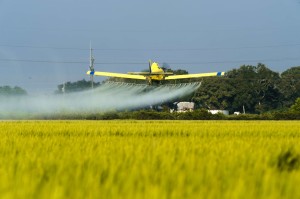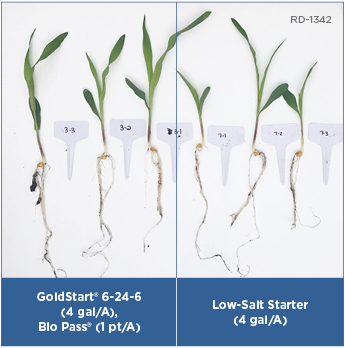The Role Of Aerial Application
For decades aerial application has been a staple in many parts of the U.S., from forests in the West to pastures in the Plains to rice fields in the South. On limited occasions aerial operators have been called to the Midwest as to serve as “firemen,� extinguishing unexpected insect outbreaks such as spider mites.
But a number of factors have fostered explosive growth in the aerial segment these past few years. The advent of new corn fungicides designed to be applied at tassel has taken aerial work to a new level, particularly in the Midwest. Plus, advances in flight technology that allow for more timely, efficient, and effective crop protection product applications have made aerial a valuable addition to – and in some cases alternative to – ground approaches.
In fact, fans such as Craig Bair, aerial SSRE manager at Wilbur-Ellis Co., could list several advantages of aerial, including the ability to treat more acres per day than ground rigs; the ability to make extensive applications in busy, narrow treatment windows, especially if weather/soil conditions are unfavorable; the absence of crop damage; and the lack of soil compaction.
Specific to corn, he says: Research has shown that fungicide applications made to corn at the VT stage by air are more effective because the product is distributed to the upper half of the plant where it’s needed for better ear development.
Corn Demands, Aircraft Evolve
CropLife reported on the corn phenom four years ago, as retailers scrambled to secure pilots to treat corn with the new strobilurin fungicides. This market has only grown since then. The products provide strong protection against disease, but they also have proved to generate a “plant health� benefit that give yields a decided bump.
That boost has now been widely documented, though exact figures may vary by region and disease pressure. Dr. Scott Bretthauer, pesticide safety extension specialist with the University of Illinois, conducted a study that recorded a yield increase of 18.6 bushels per acre with an aerial application of fungicides. BASF’s latest product HeadlineAMP, for instance, is showing average increases of 12.8 bushels, reports Dr. Gary Fellows, tech service fungicide and seed treatment. Ag retailer Mike Carrell at Ceres LLP, Wingate, IN, has customers adding 7-10 bushels per acre. Bottom line: Growers have increasingly become believers in these products and are requesting aerial service, often through their retailers.
Advances in aircraft have also fueled aerial application popularity. “For all intents and purposes, planes are twice as big as they were,� says Tony Goede, aerial manager with BASF. The most common planes in use today are powered by a turbine engine, cut huge swaths across fields, and carry 400 to 500 gallons of product. In fact, Air Tractor Inc. has a 1000-gallon plane in development that, though targeted for firefighting, may be popular with its aerial application customers who currently own the company’s 800-gallon aircraft.
The move to these larger turbine planes has not only added power for longer hours and bigger jobs, the craft have proven to be more reliable and need less maintenance than the previously used piston planes, says Jim Hirsch, president of Air Tractor.
“By moving into one or two larger aircraft instead of several smaller ones, operators are able to become more efficient and reduce overhead,� says Hirsch. Some pilots we talked with still use the smaller Cessna-type planes that have capacities of 160 gallons. They’re still plenty effective, particularly for manuevering in smaller fields.
In addition to turbine technology, planes now offer more advanced boom construction and placement, nozzle design, and flow controls. These upgrades make for more accurate applications, but the new flow controls in particular mean that pilots don’t need to work as hard in the airplane to keep their speed constant across the field, says Steve Benoit, owner of Benoit Aerial Spraying, Kankakee, IL.
As in ground work, GPS has been a great boon for aerial application, with 99% of pilots now using it for navigation, according to National Agricultural Aviation Association’s (NAAA) 2012 survey.
The past few years have also brought a host of advances in mapping software, the most notable being the ability to tie orders to georeferenced fields. Operators can create job maps in their offices more easily, then download them onto memory sticks for pilots to load in the computer in the cockpit. Benoit appreciates the ability to now receive these application jobs via e-mail – jobs that fertilizer dealers he partners with have booked with growers.
One powerful new resource is AgSync, a web-based Internet hub that many Midwest retailers and aerial firms now use for order management. After securing a job order the company transmits it, connecting GPS systems on planes with computers at the office; on the backside of an application, the system creates as-applied maps. Goede reports that more than 600 retail locations are utilizing the service, with more than 40 aerial applicators linked in.
Experts we spoke with see a continuing bright future for aerial in part because this is a good time for agriculture products globally. Andrew Moore, executive director of NAAA, points out that growing populations and middle classes are demanding meat daily, with the accompanying demand for corn. He says growers are more likely to use yield aids such as corn fungicides, applied by air, when commodity prices are up.
In addition, chemical manufacturers are developing ways to keep the aerial market intact and the growth consistent, says Goede. They continue to come out with new fungicides and more product labels that include aerial directions. Plus, new herbicides are coming available for aerial application, particularly in Western states.






